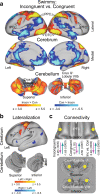The Stroop effect involves an excitatory-inhibitory fronto-cerebellar loop
- PMID: 36631460
- PMCID: PMC9834394
- DOI: 10.1038/s41467-022-35397-w
The Stroop effect involves an excitatory-inhibitory fronto-cerebellar loop
Abstract
The Stroop effect is a classical, well-known behavioral phenomenon in humans that refers to robust interference between language and color information. It remains unclear, however, when the interference occurs and how it is resolved in the brain. Here we show that the Stroop effect occurs during perception of color-word stimuli and involves a cross-hemispheric, excitatory-inhibitory loop functionally connecting the lateral prefrontal cortex and cerebellum. Participants performed a Stroop task and a non-verbal control task (which we term the Swimmy task), and made a response vocally or manually. The Stroop effect involved the lateral prefrontal cortex in the left hemisphere and the cerebellum in the right hemisphere, independently of the response type; such lateralization was absent during the Swimmy task, however. Moreover, the prefrontal cortex amplified cerebellar activity, whereas the cerebellum suppressed prefrontal activity. This fronto-cerebellar loop may implement language and cognitive systems that enable goal-directed behavior during perceptual conflicts.
© 2023. The Author(s).
Conflict of interest statement
The authors declare no competing interests.
Figures








References
-
- Stroop JR. Studies of interference in serial verbal reactions. J. Exp. Psychol. 1935;18:643–662. doi: 10.1037/h0054651. - DOI
Publication types
MeSH terms
Associated data
LinkOut - more resources
Full Text Sources

